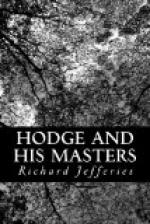At dinner, while sipping his claret, Phillip delivered his opinion upon the agriculture of the district, which he had surveyed from his bicycle. It was incomplete, stationary, or retrograde. The form of the fields alone was an index to the character of the farmers who cultivated them. Not one had a regular shape. The fields were neither circles, squares, parallelograms, nor triangles. One side, perhaps, might be straight; the hedgerow on the other had a dozen curves, and came up to a point. With such irregular enclosures it was impossible that the farmer could plan out his course with the necessary accuracy. The same incompleteness ran through everything—one field was well tilled, the next indifferently, the third full of weeds. Here was a good modern cattle-shed, well-designed for the purpose; yonder was a tumble-down building, with holes in the roof and walls.
So, too, with the implements—a farmer never seemed to have a complete set. One farmer had, perhaps, a reaping machine, but he had not got an elevator; another had an elevator, but no steam-plough. No one had a full set of machinery. If they drained, they only drained one field; the entire farm was never by any possibility finished straight off. If the farmer had two new light carts of approved construction, he was sure to have three old rumbling waggons, in drawing which there was a great waste of power. Why not have all light carts? There was no uniformity. The farming mind lacked breadth of view, and dwelt too much on detail. It was not, of course, the fault of the tenants of the present day, but the very houses they inhabited were always put in the wrong place. Where the ground was low, flat, and liable to be flooded, the farmhouse was always built by a brook. When the storms of winter came the brook overflowed, and the place was almost inaccessible. In hilly districts, where there was not much water, the farmhouse was situate on the slope, or perhaps on the plateau above, and in summer very likely every drop of water used had to be drawn up there from a distance in tanks.
The whole of rural England, in short, wanted rearranging upon mathematical principles. To begin at the smallest divisions, the fields should be mapped out like the squares of a chessboard; next, the parishes; and, lastly, the counties. You ought to be able to work steam-ploughing tackle across a whole parish, if the rope could be made strong enough. If you talked with a farmer, you found him somehow or other quite incapable of following a logical sequence of argument. He got on very well for a few sentences, but, just as one was going to come to the conclusion, his mind seized on some little paltry detail, and refused to move any farther. He positively could not follow you to a logical conclusion. If you, for instance, tried to show him that a certain course of cropping was the correct one for certain fields, he would listen for awhile, and then suddenly declare that the turnips in one of the said fields last year were a failure. That particular crop of turnips had nothing at all to do with the system at large, but the farmer could see nothing else.




